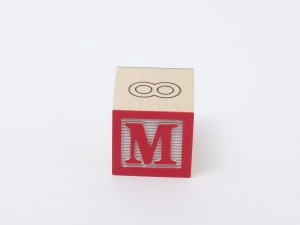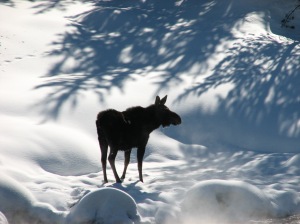Snow with Moose
Guide to the incremental, to the sifted mass. The Phoenician mem shifted
shapes, but always suggested water.
Moose likely derives from the Algonquian descriptor “he strips away.”
The Japanese character for water, mizu, evokes currents.
Moose are solitary creatures and do not form herds. A bilabial consonant,
M is a primary sound throughout the world.
The prehensile upper lip undresses branches and grabs shoots.
Wavering, I share the lack of definition, of clarity in design and choice.
The sound is prevalent in the words for mother in many unrelated tongues,
from Hindi to Mandarin, Hawaiian to Quechua, and of course English.
Eleven strokes compose the Japanese character for snow.
A smile would reveal no upper front teeth.
Long legs enable adults to manage snow up to three feet deep. Under water,
individual flakes striking the surface sound similar, despite size disparities.
It can also accurately be classified as a mineral.
Solitude to connection, dark on white. The lone traveler.



Reading this makes me wish for snow and Moose. But in London, Ontario, the only guarantee we have is snow without Moose. 😉
LikeLiked by 2 people
We seldom see snow here, and moose, of course , would not fare well in this state. Too hot, insufficient water. But the letter M is abundant!
LikeLiked by 1 person
I haven’t seen snow in a few years because I’m not in Canada for the winter usually. Never have seen a moose in London.
I’m in Trinidad most of the time so I was hoping that I’d be seeing some snow because I wanted to take photos. Looks like this isn’t happening. sigh.
And yes, the letter M is abundant! 😉
LikeLike
I like the poetry, images, and interesting juxtapositioned streams of thought. Thank you.
LikeLiked by 1 person
These connections, imagined or not, seem to find me. And thank you for your kind words.
LikeLiked by 1 person
As a student of ancient languages the reference to the Phoenician mem and its association with water clenched my interest. And the way you weave “M” and Moose and snow together makes for a mentally fascinating read. Great work!
LikeLiked by 1 person
Thanks very much. As you might suspect, I’m fascinated with language and how our written characters might have evolved. Rich fields to harvest!
LikeLiked by 1 person
Rich fields indeed.
LikeLiked by 1 person
Absolutely lovely
LikeLiked by 1 person
Thank you, Christina.
LikeLiked by 1 person
Wow! ‘The lone traveler’ – stunning ending to a beautiful poem.
LikeLiked by 1 person
Delighted you like it. Thank you.
LikeLiked by 1 person
rvvrrvtv
LikeLike
I’m not sure what your comment means, but thank you.
LikeLiked by 1 person
Rvvrrvtv:
a traditional Christmas greeting common among northern Finno-Ugric people (Finnish), usually accompanied by spontaneous, improvised song-spiel. The most popular of these is “Lilja The Dainty,” a Yuletide morality play about a young girl who is confronted by Lohikäärme, a local dragon who wishes to separate Lilja from her beloved goat Tyhmä. Though confident in his mission, the dragon however is flummoxed, and ultimately defeated, when Tyhmä argues, via Kant’s categorical imperative, that ontologically dragons only exist in the imagination, causing Lohikäärme to belch loudly then disappear. The tale concludes on a happy note when the dragon reappears and dispenses walnuts to all the boys and girls who have been good all year. Many scholars have raised doubts as to the authenticity of tale’s finale, saying it is a later inclusion; the proof being that the tale’s epilogue closes with a soliloquy by Lilja praising the quality and reasonable pricing structure of SONY products…
LikeLiked by 1 person
i haven’t seen a moose since i was in the canadian rockies in the early 90s. always solitary. never plural. snow, on the other hand, is always plural. usually a plethora of plural. anyway, nice juxtaposition.
LikeLiked by 1 person
The moose was loose! Don’t believe I’ve ever seen one.
LikeLike
Hi. It’s me Tom Balistreri.
Forgive me for posting this in your comments.
I wanted to let you know that I still read, follow and enjoy your posts.
I deleted my old blog (originally called “Balderdash To Epiphany” and then simply “Tom Balistreri’.)
My reason was because I had changed direction in my writing and although I had almost 2000 followers I realized they signed up when I was writing humor.
I wanted to have a more focused blog without my old posts (no matter if it was liked it or not.)
So now I’m writing under the title “Lantern Words”
https://lanternwords.wordpress.com/
If this stuff is not you cup of tea, that’s ok I understand.
But if you’re interested, that’s were I hang my hat now.
Take care,
Tom
LikeLiked by 1 person
Thanks for letting me know, Tom. By the way, I just retrieved this reply from my spam folder. I’m not sure why it was there.
LikeLiked by 1 person
So rich, Bob, and not just because I have been graced by moose encounters in the Upper Peninsula. I found my lips forming the word “moose” and understanding, then, a bilabial consonant. And thinking of the moose’s leathery upper lip, those long legs; deep snow and solitude. Lovely
LikeLiked by 1 person
Thanks, Cate. I’m taken with the fact that so many of a child’s first words begin with a bilabial consonant, whether “m,” “b” or “p.” It makes sense, but I’d never thought about it until I started reading about moose, and somehow followed a thread to bilabial consonants. Lightning strikes me from so many different directions!
LikeLike
Melancholy, haunting, profound. Beautiful.
LikeLiked by 1 person
Thank you, Pat.
LikeLike
I am still recovering from “Self-Portrait With Umeboshi.” Listening to snow from underwater? Brilliant line. Nothing but brilliant lines from you!
LikeLiked by 1 person
I just ate umeboshi three days ago. Still a favorite treat. A little rice, a few umeboshi. Nothing better! And thanks again for your kindness. Much appreciated.
LikeLiked by 1 person
Umeboshi and natto are the two gaijin “test foods” my Japanese friends had me eat when I first arrived, to see if I could “fit in with society.” LOL! I had to eat them both straight with nothing else. I still hate umeboshi to this day with a passion. And natto tastes terrible on its own… BUT… natto with a little mustard and soy sauce is one of the most delicious things on the planet! In my region of Japan (Kansai), people usually hate natto, especially the smell… and always look at me like I’m crazy for eating so much of it. A couple of packs of natto and a bowl of freezing cold zarusoba? Pure Heaven! But umeboshi? Horrible. 🙂
LikeLiked by 1 person
Ha! I’ve never tried natto, but from what I’ve heard, it would be an acquired taste. But I’d be willing to try it, especially with the right beer.
LikeLiked by 1 person
Really like the wavering concretizations. Don’t mean to be pedantic, but ‘mem’ predates Phoenicians by at least 400 years.
LikeLiked by 1 person
Thanks, David. I’m likely working from an outdated or non-scholarly source. Could you offer a title or two for me to read?
LikeLike
More than you asked for, sorry:
Albright, W.F. “”The Early Alphabetic Inscritpions from Sinai and their decipherment.” BASOR 110 (April 1948)
Albright, W.F. The Proto-Sinaitic Inscriptions and their Decipherment. Vol. XXII. Harvard Theological Studies, Cambridge, MA: 1966.
Canter, Martha L. and Keith N. Schoville, ed. Sign, Symbol, Script: An Exhibition on the Origins of Writing and the Alphabet. Madison, Wisconsin: University of Wisconsin Press, 1984.
Cross, F.M., “The Origin and Early Evolution of the Alphabet” EI (1967):10
Denman, F. The Shaping of our Alphabet. New York: 1955.
Gaur, Albertine. A History of Writing. London: The British Library, 1984.
Gordon, Cyrus Herzl. Forgotten Scripts: The Story of their Decipherment. London: Thames and Hudson, 1968.
Sampson, J. Writing Systems. Stanford: Stanford University Press, 1985.
Senner, Wayne A., ed. The Origins of Writing. Lincoln, Nebraska: Univ. of Nebraska Press, 1989.
Sprengling, Martin, The alphabet, its rise and development from the Sinai inscriptions, Chicago:The University of Chicago Press, 1931
Trustees of the British Museum, ed. Reading the Past: Ancient Writing from Cuneiform to the Alphabet. London: British Museum Press, 1990.
LikeLike
Not at all, David. Thank you.
LikeLike
brilliantly composed. this form of expression is extremely difficult to pull off (or maybe “strip away”). Too often the poem becomes just a flat list of facts somehow associated to one another, but with under surface connection bubbling up to the surface. The ending ties things together, yet at the same time completely changes everything that has come before it, putting into question even the nature of the form the thoughts are expressed (solitude and distance (disconnected) voice).
LikeLiked by 1 person
Thank you, Doug. This is a form/style I’ve been working with for the past three years, with varying degrees of success. It’s challenging and interesting.
LikeLiked by 1 person
Pingback: Snow with Moose | wwwpalfitness
So richly painted and layered. Has elements of the vision of someone like Francis Ponge and as wonderful.
LikeLiked by 1 person
Ponge! One of my early favorites. Thank you.
LikeLiked by 1 person
Not at all, Robert. I think your piece is wonderful and it completely captured my imagination. Ponge was a favorite of mine as well, though the prose poem has always eluded me. Happy Holiday!
LikeLiked by 1 person
Pingback: 191 Days: Reflections on Ornette Coleman | I Am Daniel Schnee